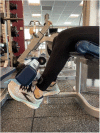Return to Play Considerations After Patellar Instability
- PMID: 36367684
- PMCID: PMC9789273
- DOI: 10.1007/s12178-022-09792-1
Return to Play Considerations After Patellar Instability
Abstract
Purpose of review: To discuss the treatment options and rehabilitation protocols after non-operative and operative treatment of patellar instability, and to discuss expected return to play outcomes and functional performance with non-operative and operative treatment of patellar instability.
Recent findings: A criterion-based program assessing range of motion, joint effusion, strength, neuromuscular control, proprioception, agility, and power are critical measures to assess when rehabilitating this population. A series of functional tests including quadriceps strength testing, single-limb hop testing, lateral step-down test, the side hop test, the lateral leap and catch test, the Y-balance test, and the depth jump should be considered when determining an athlete's return to sport clearance. These objective measures combined with psychological readiness and a comprehensive understanding of the sports-specific tasks required for participation should be considered when evaluating an athlete's ability to safely and successfully return to sport. We discuss rehabilitation management when working with non-operative and operative management of patellar instability and provide considerations for clinicians working with these athletes to facilitate safe return to sport.
Keywords: MPFC; MPFL; Medial patellofemoral complex; Medial patellofemoral ligament; Patellar dislocation; Patellar instability; Patellofemoral; Reconstruction; Return to play; Return to sport.
© 2022. The Author(s), under exclusive licence to Springer Science+Business Media, LLC, part of Springer Nature.
Conflict of interest statement
The authors did not receive any funding or grants in support of the research for or preparation of this work. The authors declare no conflict of interest.
Figures





References
Publication types
LinkOut - more resources
Full Text Sources
Research Materials

